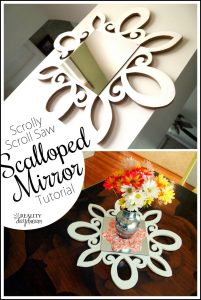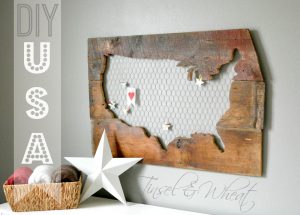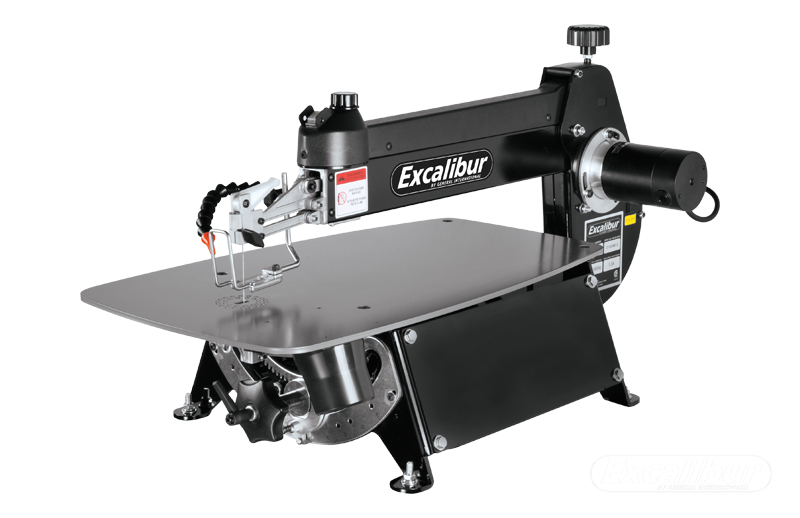Have you ever wanted to make your own word art, puzzles, figurines, or interesting patterns to hang on the wall? A scroll saw is a very unique piece of machinery that has a very fine blade to cut wood. Some patterns have very small curves that would be almost impossible to cut out with any machine other than a scroll saw. What are some examples of projects you can make with a scroll saw?
- Marquetry – The craft of adding cut veneer pieces to a surface form a pattern
- Intarsia – The craft of inlaying wood pieces and patterns to make figurines, displays, models. It can also be on floors, walls, table tops, or other furniture.
- Word Art
- Puzzle pieces
What you can expect to read:
DIY Scroll Saw Projects
- Scrolly Scalloped Mirror by Bethany @ RealityDaydream.com

- New “Old” Distressed Barn Wood Word Art by Dreamingindiy.com

- Rustic Barn Wood USA by Miranda @ TinselAndWheat.com

Benefits of a scroll saw
- It’s very quiet, much more quiet than a band saw
- You can make extremely intricate cuts with its smaller, more precise blade
- It’s easier to make a pierce cut where you don’t cut through the border of your work
- It leaves a superior surface finish
- Better control over your cuts resulting in a better end product
What to Look for in a Scroll Saw
While it’s safe to go cheap on some tools there are others you should consider paying more for if you’re a professional. It boils down to the fact that manufacturers use higher quality parts in higher priced tools. Especially with scroll saws, this results in less vibration, more precise cuts, and a better finished product. First, look for a saw that is quiet and has minimal vibrations. Second, can you change the blade quickly when you need to? You’ll spend less time changing blades and more time cutting. Third, check that you can adjust the blade tension easily. You may want to look for a work light or a dust blower too.
With all of that said, budget can often dictate tool choice. If you’re a beginner to scroll saws, you may not have the budget for a high end saw and you may have to be willing to accept a less than perfect result in your work. Professionals may not be willing to accept anything less than perfect, but they may also may have larger. It all depends where you’re coming from and where you’re at in the hobby. My goal is to arm you with enough information to make an educated decision for your hobby.
To recap, look for the following in a scroll saw:
- Minimal vibration (a heavier saw reduces vibration)
- Ability to change blades quickly
- Easily adjustable blade tension
- Tilting bed or tilting head (if you plan on making angled cuts)
- Dust collection mechanism (to minimize cleanup)
- Work light (a bonus, but not necessary)
Which Scroll Saw Should You Buy?
My Top Pick
The DeWALT DW788 has elevated itself to the top of the list of quality scroll saws. This industry used to be dominated by Excalibur but manufacturing and trademark changes opened up the market for new comers. First off, it’s very easy to change the blades and it’s very quiet. Lifting the head to change the blade shouldn’t take any longer than a few seconds. Also lift the head to easily thread the blade through wood to make a pierce cut. You’ll also enjoy how quiet it is if you live in an urban area such as an apartment. It’s also easy to adjust the tension and speed if needed too. Notice the weight compared to other scroll saws. This is my number one recommendation due to how smooth it cuts and how well its built.
Features
- 20 inch throat depth
- 400-1750 strokes per minute
- Cast iron table size of 16″ x 23-3/4″
- Table tilts 45 degrees left and right
- Tool free blade changes
- 56 lbs
- 3 year warranty
You may want to look in to an arm lifter for a small upgrade to make your cutting a little easier. It’s a small accessory that automatically locks the cutting head up if you need to change blades or reposition your work. It may not seem like a big deal but it can greatly improve your workflow.
My Value Pick
Remember Wen? The WEN 3920 is a 16 inch scroll saw that has a lot of features and packs great value for where it is in the price spectrum. If you’re just starting out and don’t have a lot of money for a top of the line saw, you may want to start here until you work up your skills and upgrade at a later point. Once you’ve got enough practice, you’ll know what you like an don’t like in your saw. You really can’t go wrong at this price point as a beginner. You’ll notice it won’t have the weight of higher end saws and may not have the same smooth cutting quality, but it’ll sure allow you to get into the hobby without emptying your wallet.
Features
- 16 inch throat depth
- Variable Speed: 550-1600 strokes per minute
- Unique blade mounting system allowing you to turn the blade 90 degrees so your cuts are not limited by the throat size
- 16″x11″ table size
- Table tilts 45 degrees left
- Cast iron base
- LED work light
- 27.5 lbs
- 2 year warranty
What are the Best Scroll Saw Blades?
I recommend only Flying Dutchman blades. They are made in Germany using hardened steel to make it feel like you’re cutting butter. Germans are known for their precision and quality in manufacturing. These blades are no exception of great example of German quality. Once you install them, you’ll notice how much easier it is to make the smaller cuts and turns for intricate pieces. You’ll also get more cutting time per blade since they’re higher quality.
Additional Scroll Saw Resources
- What happened to Excalibur? General International used to make a product called Excalibur that was top of the line many years ago. It’s a long story, but a sequence of events has left the brand, manufacturing, and rights with other companies. Read the article I linked to take a look at what Travis from Scrollsawvillage received from Peter King of King Canada to understand what happened to the brand.
- Inkscape – Open source vector graphics editor. Great to make your own patterns.
- How to Create Patterns from Photos in Photoshop – An article in PDF from Scrollsawer.com. Here’s the same article if you’re using GIMP
- Judy Gale Roberts – A legend in the industry. Purchase patterns and see examples of her work.
- How to use Inkscape to turn a hand drawing into a pattern





